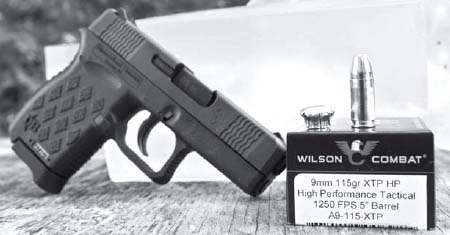
A block of ordnance gelatin is not a bad guy —but bad guys don’t show up at test labs asking to be shot.
In the late 1980s, the FBI established 10-percent ordnance gelatin as its soft tissue emulator. Since then, most bullet manufactures have adopted 10-percent ordnance gelatin as a test medium. This does not mean ordnance gelatin at any mix ratio exactly simulates human or animal tissue. Nor does it mean it’s the only media used by bullet manufacturers. It is, however, the most common terminal ballistics testing media.
Gelatin (type B) is obtained by the partial hydrolysis of collagen derived from the skin, white connective tissue, and bones of animals. Gelatin consists, approximately, of 86 percent protein, 12 percent moisture, and two percent ash “mineral salt.” Typical food-grade gelatin will not provide the right consistency. Ordnance gelatin provides a repeatable media for testing a bullet’s penetration, expansion, and integrity, all of which influence its terminal performance.

If there is an industry standard when it comes to a bullet testing media, it is ordnance gelatin. A 10-percent gelatin mixture is most often used.

Finding a suitable container for molding gelatin can be troublesome, especially for the homebound ballistician. Used, half-gallon cardboard milk cartons are a great solution to this dilemma.
Most users mix gelatin in open molds that are then placed in a refrigerator. Gelatin doesn’t have an appealing odor, and until it sets up it can spill. An easy way to make ordnance gelatin is to use half-gallon cardboard milk or orange juice containers with a screw-off top for a mold. To contain the bullets from most defensive handgun cartridges, you’ll need three, 4.66-pound blocks formed in these half-gallon containers. You can place them end to end on a flat surface, which will give you 24 inches of gelatin to shoot into.
It’s generally rather easy to shoot twice into one end of the three blocks and twice into the other end. This procedure allows you to test at least four bullets with three gelatin blocks; the center gelatin block becomes the catch block. Is this to the FBI standard, which specifics a larger block and that blocks be fired into only once? Nope. Does it matter? Only if you’re the FBI. As long as bullet paths don’t cross, your results should be sound. Actually, tests have shown that even when they do cross, results vary by such a minimal amount it’s statistically irrelevant.
Ten-percent ordnance gelatin is called 10-percent ordnance gelatin because it’s mixed at a 9:1 by-weight ratio with water. One of these half-gallon containers will make a block of 10-percent ordnance gelatin that weighs about 4.66 pounds. This means that, for each block, you will need .466-pound (7.45 ounces) of gelatin and 4.2 pounds (four pounds and 3.2 ounces) of water. Measure out the water and gelatin. You’ll need a candy thermometer, funnel, stirring spatula, mop bucket, and a one- to two-gallon pot with which you can heat the water on the stove.


It’s easy to see the difference in terminal performance, when testing in blocks of 10-percent ordnance gelatin. The real question is how the differences translate to the bullet’s actual terminal performance in a bad guy. All we can do is guess.
Heat the water to 140 degrees Fahrenheit and add 1.7 milliliters of foam eater and 0.5 milliliters of cinnamon oil. Foam eater cuts down the foam while mixing, and the oil of cinnamon aids in the prevention of bacteria (and lessens the nasty smell). With the help of a friend, pour the water into a bucket while pouring the gelatin in at the same time. Then, aggressively stir the mixture for about 10 minutes or until the gelatin is dissolved
Using a funnel, fill the half-gallon container through the screw-off cap opening. Screw on the cap and let the container cool for four hours at room temperature; you can write the time and date on the containers with a Sharpie. After cooling, place the container in the refrigerator for 24 hours. Temperature should be about 39 degrees Fahrenheit.
The temptation will be to adjust your percentages of the mix by the number of blocks you wish to make. The problem with this is that working with more than a half-gallon becomes tedious in a home kitchen, and the potential for a divorce-causing mess exists. Mix your gelatin block one container at a time.
The FBI requires gelatin blocks be calibrated. This is done by firing a .177-caliber steel BB at 590 fps, plus/minus15 fps, into the gelatin. The BB should penetrate 2.95 to 3.74 inches. I used to do this, but after never having a block fail the test, I stopped. Do you have to calibrate your blocks by the FBI method? Only if you’re the FBI. Can blocks that have not been calibrated yield inconsistent results? Yep, and again, tests have shown slight variations in block consistency impact the results only minimally. Follow the preparation instructions and your tests will provide meaningful information.
These cardboard containers make transporting gelatin to the range in a cooler easy. When you set them out to shoot, you just peel the cardboard off. Always shoot into gelatin on a safe range and don’t assume the bullet will stop in the gelatin or that it will not come out the side. It is not safe to stand beside gelatin blocks when they are being shot. All common firearms safety practices should be observed.

It might also be useful to test bullets through a common intermediate barrier like denim or some other fabric. After all, it’s unlikely you’ll ever have to shoot a naked bad guy.